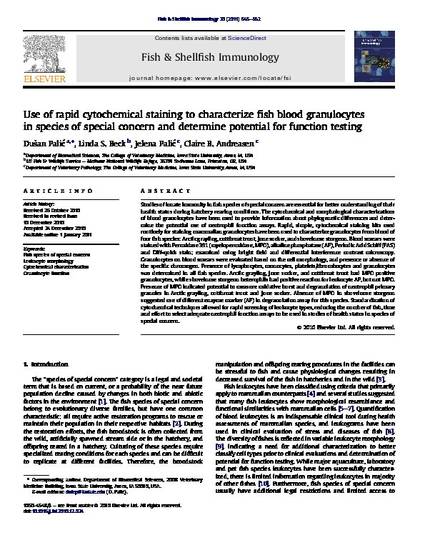
Article
Use of Rapid Cytochemical Staining to Characterize fish blood granulocytes in Species of Special Concern and Determine Potential for Function Testing
Fish & Shellfish Immunology
Document Type
Article
Disciplines
Publication Version
Published Version
Publication Date
2-1-2011
DOI
10.1016/j.fsi.2010.12.024
Abstract
Studies of innate immunity in fish species of special concern are essential for better understanding of their health status during hatchery rearing conditions. The cytochemical and morphological characterizations of blood granulocytes have been used to provide information about phylogenetic differences and determine the potential use of neutrophil function assays. Rapid, simple, cytochemical staining kits used routinely for staining mammalian granulocytes have been used to characterize granulocytes from blood of four fish species: Arctic grayling, cutthroat trout, June sucker, and shovelnose sturgeon. Blood smears were stained with Peroxidase 391 (myeloperoxidase, MPO), alkaline phosphatase (AP), Periodic Acid Schiff (PAS) and Diff-quick stain; examined using bright field and differential interference contrast microscopy. Granulocytes on blood smears were evaluated based on the cell morphology, and presence or absence of the specific chromogen. Presence of lymphocytes, monocytes, platelets/thrombocytes and granulocytes was determined in all fish species. Arctic grayling, June sucker, and cutthroat trout had MPO positive granulocytes, while shovelnose sturgeon heterophils had positive reaction for leukocyte AP, but not MPO. Presence of MPO indicated potential to measure oxidative burst and degranulation of neutrophil primary granules in Arctic grayling, cutthroat trout and June sucker. Absence of MPO in shovelnose sturgeon suggested use of different enzyme marker (AP) in degranulation assay for this species. Standardization of cytochemical techniques allowed forrapid screening of leukocyte types, reducing the number of fish, time and effort to select adequate neutrophil function assays to be used in studies of health status in species of special concern.
Rights
Works produced by employees of the U.S. Government as part of their official duties are not copyrighted within the U.S. The content of this document is not copyrighted.
Language
en
File Format
application/pdf
Citation Information
Dušan Palić, Linda S. Beck, Jelena Palić and Claire B. Andreasen. "Use of Rapid Cytochemical Staining to Characterize fish blood granulocytes in Species of Special Concern and Determine Potential for Function Testing" Fish & Shellfish Immunology Vol. 30 Iss. 2 (2011) p. 646 - 652 Available at: http://works.bepress.com/claire_andreasen/24/

This article is from Fish & Shellfish Immunology 30 (2011: 646, doi:10.1016/j.fsi.2010.12.024.